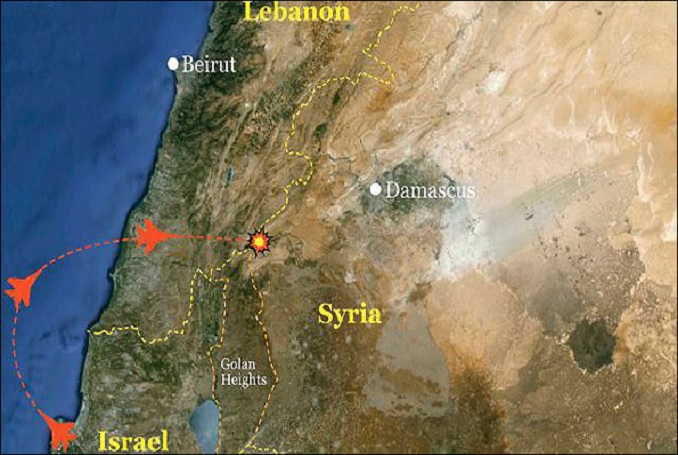
By Jonathan Cook – Nazareth
The hidden battle in Syria – the one that rarely appears on our television screens – has been raging for years between Israel and a coalition comprising the Syrian government, Iran and the Lebanese militia Hezbollah.
Watching over the proceedings without directly intervening has been Russia, although that might be about to change.
The prize is control over Syrian territory but the battlefield is Syria’s skies.
According to United Nations figures, the Israeli military violated Syrian airspace more than 750 times in the four-month period leading up to last October, with its warplanes and drones spending some 3,200 hours over the country. On average, more than six Israeli aircraft entered Syrian airspace each day in that period.
Powerful rocket strikes reported on two sites in Syria on Sunday were widely attributed to Israel. Since war broke out in Syria just over seven years ago, Israeli fighter jets are believed to have carried out hundreds of offensive missions.
Israel regards the stakes as high. It wants Syria to remain an enfeebled state, ensuring Bashar Assad’s government cannot again become a regional foe. But Israel also needs to prevent other powerful, hostile actors from being drawn into the resulting vacuum.
Israel achieved one major aim early on: Western powers insisted that the Syrian government be disarmed of its large arsenal of chemical weapons, Damascus’s only deterrent against an Israeli nuclear threat.
Since then, Israel’s focus has shifted to Iran and blocking its ambitions on various fronts: to prop up Assad, establish a military presence close to Israel’s northern border and use Syria as a conduit for transferring arms to Hezbollah.
Iran’s aim is to recreate a balance of terror between the two sides and free itself from diplomatic isolation; Israel’s is to maintain its military pre-eminence and dominance of the Middle East’s skies.
In addition, Israel seeks to exploit Syria’s collapse to claim permanent title over the Golan Heights, which it seized from Syria in 1967 and later annexed in violation of international law.
It is unlikely to have been a coincidence that Sunady’s large attacks on Syria occurred moments after Mike Pompeo, the hawkish new US Secretary of State, had visited Jerusalem and Israeli prime minister Benjamin Netanyahu had spoken to US President Donald Trump by phone. At least one of the targeted sites was reported to be a base at which Iranian personnel were stationed.
Iran was apparently the focus of Netanyahu’s talks, including discussions about the fate of the 2015 nuclear accord with Iran, due for renewal next month. Israel hopes the US will tear up the deal, allowing sanctions to be intensified and forcing Iran to concentrate on its diplomatic woes and mounting protests at home rather than project its influence into Syria.
In the meantime, tensions in Syria are ratcheting up. Unusually, Israel admitted in early April that it was behind a strike on an Iranian base in Syria that killed seven Iranian troops. According to the Wall Street Journal, Israel targeted an anti-aircraft battery under construction, one Tehran hoped would limit Israel’s freedom to patrol Syria’s skies.
The attack followed Israel’s interception of a drone over northern Israel, presumably dispatched to gain the same kind of intelligence about Israeli military bases that Israel has of Iranian bases in Syria.
According to a senior Israeli military official, the move from proxy clashes to direct ones has “opened a new period” of hostilities. Defense Minister Avigdor Lieberman has warned that Israel is prepared to prevent Iran’s entrenchment in Syria, “regardless of the price”.
Echoing him, US Defense Secretary James Mattis warned on Thursday that it was “very likely” Israel and Iran were on a collision course. Neither appears to believe it can afford to climb down.
But Israel’s gameplan not only risks a dangerous escalation with Iran. It could draw Russia even deeper into Syria too.
Last week Russian officials indicated there are plans to supply the Syrian army with Russia’s advanced S-300 missile defense system. For the first time, Israeli planes would face a real risk of being shot down if they violated Syrian airspace.
So far Israel has suffered only one known loss: an F-16 was brought down in February by the Syrian army in what Israel claimed was a crew “error”.
But Israel could soon find itself with an unnerving dilemma: either it exposes its warplanes to Syrian interception, or it attacks Russian defense systems.
Russian officials have reportedly warned that there would be “catastrophic consequences” if Israel did so. But apparently unmoved, Lieberman asserted last week: “If anyone shoots at our planes, we will destroy them.”
The reality, however, is that the Russian proposal, if carried out, threatens to bring to an end impunity for an Israeli air force that has roamed the skies above parts of the Middle East at will since its lightning victory over its Egyptian counterpart in 1967.
Until now, Israeli and Russian officials have coordinated closely about their respective spheres of action in Syria to avoid mishaps. But events are spiraling in a direction that makes the status quo hard to sustain.
Russia has suggested that supplying Syria with the S-300 is retaliation against the US, a punishment for its airstrike on Syria earlier this month. The defense system is intended to ramp up the pressure on US President Donald Trump to make good on his recent promise to pull US troops out of Syria.
But it does so chiefly by harming Washington’s key ally in the region, Israel. Russia will effectively be introducing tripwires across Syria that Israel will be constantly in danger of setting off.
Israel’s largely successful ploy till now has been to play both sides of the Syrian war – assisting its US patron in keeping Iran on the back foot while co-operating with a Russian military committed to stabilizing the Syrian government.
That approach is now beginning to unravel as Israel and the US seek to prevent Moscow and Iran from helping consolidate Assad’s hold on power. The longer the fighting continues, the more likely it is that Israel will make an enemy not just of Iran but of Russia too.
(A version of this article first appeared in the National, Abu Dhabi.)
Jonathan Cook won the Martha Gellhorn Special Prize for Journalism. His books include “Israel and the Clash of Civilisations: Iraq, Iran and the Plan to Remake the Middle East” (Pluto Press) and “Disappearing Palestine: Israel’s Experiments in Human Despair” (Zed Books). He contributed this article to PalestineChronicle.com. Visit: www.jonathan-cook.net.








Interesting analysis but what choice does Israel have?